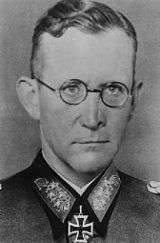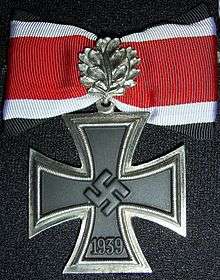Erich Marcks
| Erich Marcks | |
|---|---|
 | |
| Born |
6 June 1891 Berlin, German Empire |
| Died |
12 June 1944 (aged 53) Saint-Lô, France |
| Buried at | German War Cemetery, Marigny |
| Allegiance |
|
| Service/branch | Heer |
| Years of service | 1910–44 |
| Rank | General |
| Unit | LXXXIV Army Corps |
| Battles/wars | World War I; World War II |
| Awards | Knight's Cross of the Iron Cross with Oak Leaves |
Erich Marcks (6 June 1891 – 12 June 1944) was a German general during World War II. Marcks authored the first draft of the operational plan, Operation Draft East, for the invasion of the Soviet Union, advocating what was later known as A-A line as the goal for the Wehrmacht to achieve, within nine to seventeen weeks.
Career
Born in 1891, Erich Marcks joined the Army in 1910 and fought in World War I. He completed General Staff Training and was transferred to the Imperial General Staff Corps in 1917. Marcks was awarded the Iron Cross 2nd Class and then 1st Class, and posted to the German Supreme Command.[1] After the war, Marcks fought with the paramilitary Freikorps. He joined the Army of the German Republic (Reichsheer); between 1921 and 1933, he held several staff and command positions, and then served in the Ministry of Defense. On 1 April 1933, after Hitler came to power, Marcks was transferred to the army, serving as Chief of Staff of VIII Corps. He was a recipient of the Knight's Cross of the Iron Cross with Oak Leaves.
Operation Draft East

As Chief of Staff VIII Corps, Marcks took part in the attack on Poland and was promoted to Chief of Staff 18th Army, serving with it during the Battle of France. In the summer of 1940, Franz Halder, chief of OKH General Staff, directed Marcks to draft an initial operational plan for the invasion of the Soviet Union. Marcks produced a report entitled "Operation Draft East". Citing the need to "protect Germany against enemy bombers", the report advocated the A-A line as the operational objective of the invasion of "Russia" (sic). This goal was a line from Arkhangelsk on the Arctic Sea through Gorky and Rostov to the port city of Astrakhan at the mouth of the Volga on the Caspian Sea. Marcks envisioned that the campaign, including the capture of Moscow and beyond, would require between nine to seventeen weeks to complete.[2]
Death
Throughout the war, Marcks commanded several division- and corps-sized units. During the Allied Normandy Invasion, as commander of the LXXXIV Corps,[3] he was wounded in an Allied air attack on 12 June 1944 and died the same day. Posthumously, he was awarded the Oak Leaves to the Knight's Cross of the Iron Cross (24 June 1944) and mentioned in the OKW propaganda report, the Wehrmachtsbericht.[4]
Awards
- Iron Cross (1914) 2nd Class (25 September 1914) & 1st Class (August 1915)[1]
- Clasp to the Iron Cross (1939) 2nd Class (21 September 1939) & 1st Class (29 September 1939)[1]
- Knight's Cross of the Iron Cross with Oak Leaves
- Knight's Cross on 26 June 1941 as Generalleutnant and commander of the 101 Light Infantry Division[4]
- Oak Leaves on 24 June 1944 as general and commander of LXXXIV Army Corps[4]
- Mentioned in the Wehrmachtbericht on 13 June 1944
References
Citations
Bibliography
- Kay, Alex J. (2011) [2006]. Exploitation, Resettlement, Mass Murder: Political and Economic Planning for German Occupation Policy in the Soviet Union, 1940–1941. New York: Berghahn Books. ISBN 9781845451868.
- Scherzer, Veit (2007). Die Ritterkreuzträger 1939–1945 Die Inhaber des Ritterkreuzes des Eisernen Kreuzes 1939 von Heer, Luftwaffe, Kriegsmarine, Waffen-SS, Volkssturm sowie mit Deutschland verbündeter Streitkräfte nach den Unterlagen des Bundesarchives [The Knight's Cross Bearers 1939–1945 The Holders of the Knight's Cross of the Iron Cross 1939 by Army, Air Force, Navy, Waffen-SS, Volkssturm and Allied Forces with Germany According to the Documents of the Federal Archives] (in German). Jena, Germany: Scherzers Miltaer-Verlag. ISBN 978-3-938845-17-2.
- Thomas, Franz (1998). Die Eichenlaubträger 1939–1945 Band 2: L–Z [The Oak Leaves Bearers 1939–1945 Volume 2: L–Z] (in German). Osnabrück, Germany: Biblio-Verlag. ISBN 978-3-7648-2300-9.
- Die Wehrmachtberichte 1939–1945 Band 3, 1. Januar 1944 bis 9. Mai 1945 [The Wehrmacht Reports 1939–1945 Volume 3, 1 January 1944 to 9 May 1945] (in German). München, Germany: Deutscher Taschenbuch Verlag GmbH & Co. KG. 1985. ISBN 978-3-423-05944-2.
External links
- Fuchs, Peter (1990), "Marcks, Erich", Neue Deutsche Biographie (NDB) (in German), 16, Berlin: Duncker & Humblot, p. 125; (full text online)
| Military offices | ||
|---|---|---|
| Preceded by Generalleutnant Kurt Pflieger |
Commander of 337. Infanterie-Division 15 March 1942 – 5 October 1942 |
Succeeded by Generalleutnant Otto Schünemann |
| Preceded by none |
Commander of LXXXVII. Armeekorps 5 November 1942 – 1 August 1943 |
Succeeded by General der Infanterie Gustav-Adolf von Zangen |
| Preceded by General der Infanterie Gustav-Adolf von Zangen |
Commander of LXXXIV. Armeekorps 1 August 1943 – 12 June 1944 |
Succeeded by General der Artillerie Wilhelm Fahrmbacher |
